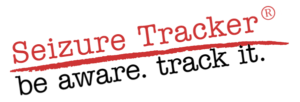Watch: Seizure Types, Seizure Action Plans, & Using Technology Devices
About the Seizure Tracker App
 Developed by parents with a son who has intractable epilepsy, Seizure Tracker® has become the world’s largest internet and mobile accessible seizure diary worldwide.
Developed by parents with a son who has intractable epilepsy, Seizure Tracker® has become the world’s largest internet and mobile accessible seizure diary worldwide.
The service is free and easy to use online anywhere in the world. You can easily create a new account at www.SeizureTracker.com.
With the main goal of improving communication between patients and doctors, Seizure Tracker users can easily track and share their seizure information, medication dosages, rescue medication administration, Vagus Nerve Stimulation (VNS) implant settings and magnet swipes, diet therapy and much more. The extensive reporting features include graphs and charts that compare seizure activity alongside the therapy and lifestyle information entered into the system.

Mobile and Voice Access
Seizure Tracker resources are accessible through web, mobile and home voice control systems. The iPhone and Android apps are real-time seizure recorders, offering a timer, video recording, rescue medication administration alerts and VNS magnet swipe recording. The Amazon Alexa skill allows Seizure Tracker users to record seizures with verbal interactions. Seizure Tracker focuses on providing an electronic seizure diary system that is easy to access and use. Providing the most accurate data to your care providers improves their ability to treat more effectively.
Research
Seizure Tracker users contribute to our understanding of epilepsy and help shape their own clinical outcomes. Participation in research is made easy through the Seizure Tracker Data Share system and the de-identified and unlinked population data exports. You can read about resulting research here.
For more information and to sign up online, visit www.SeizureTracker.com.
Paper Seizure Diaries
Keeping a seizure diary can be useful to help you record when your seizures happen and to see whether there are any specific triggers for your seizures. Sometimes, known triggers can be avoided to help reduce the number of seizures.
It can be helpful to take your completed diary to medical appointments to show your doctor or nurse. Information recorded in the diary can help your doctors see how effective your current treatment is and to plan future treatment with you.
How do I use the diary?
Record times and dates of seizures and how they affected you. Add other information such as details of your medical team, the types of seizures you have and any medication changes. Include any relevant information, like past illnesses during seizures or menstrual dates if applicable.
Download a Paper Seizure diary
Check out the Seizure Diary PDF from our friends at the Epilepsy Society. Use these paper diaries to record seizures one month at a time.
Updated 12/04/24 (KK)
